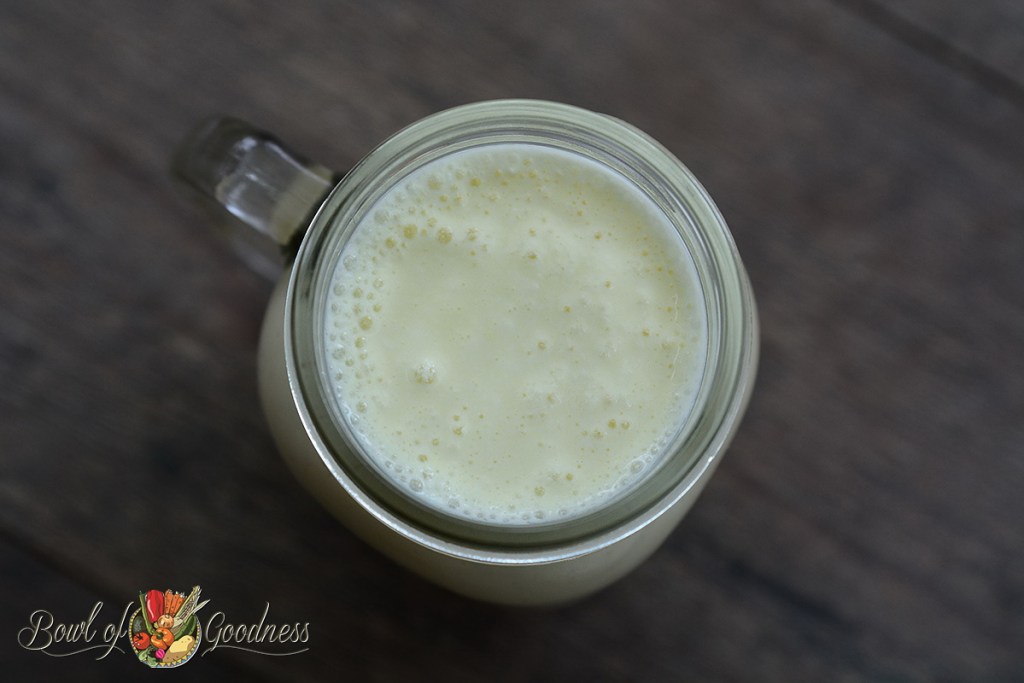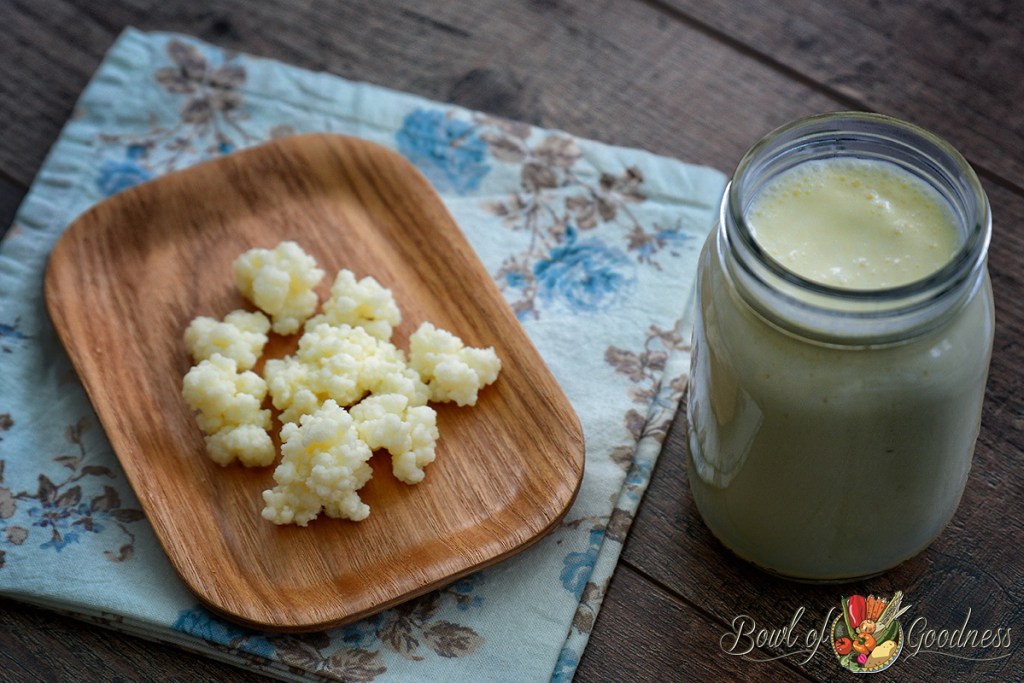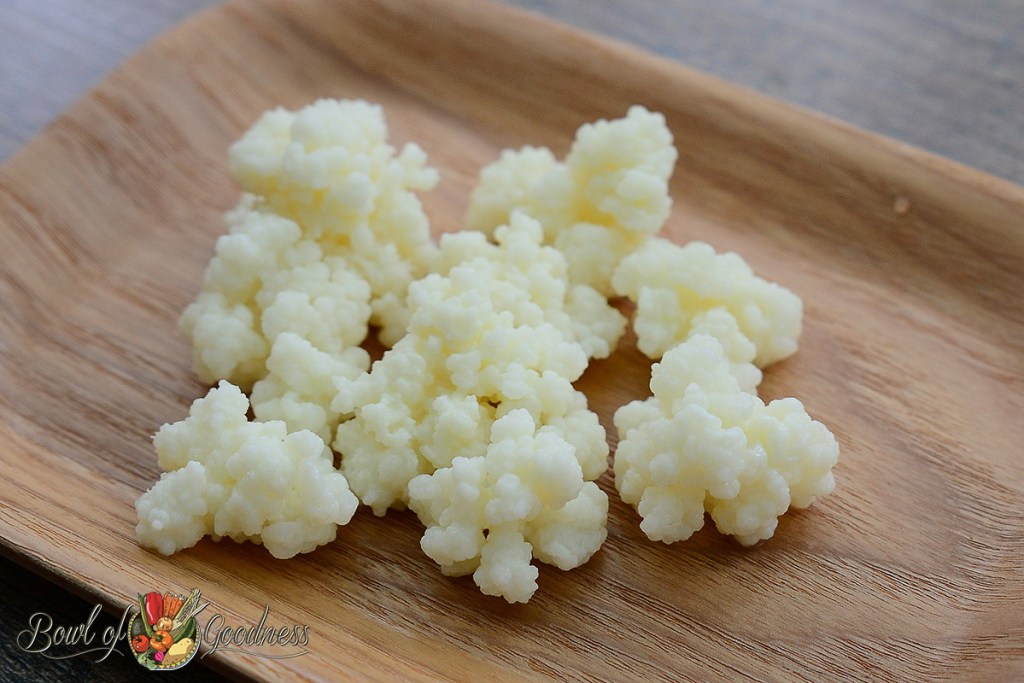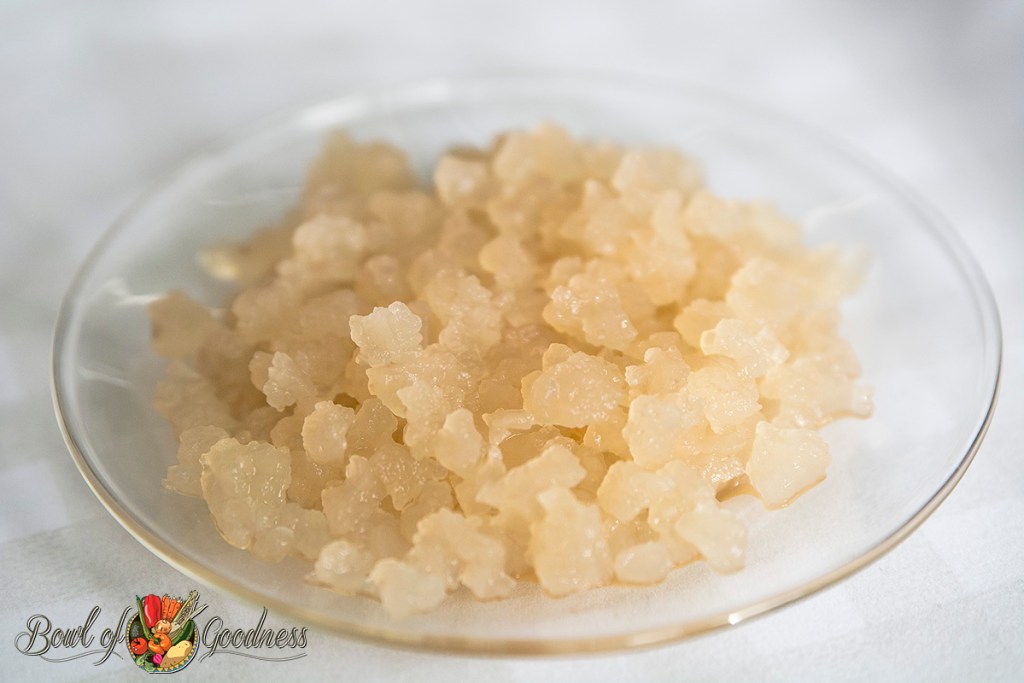Kefir is a cultured beverage that originally came from Russia. It is a fermented, enzyme-rich, looking like yogurt food, filled with friendly micro-organisms, protein, micro- and macro-nutrients, essential vitamins and minerals – vitamin B, vitamin K, magnesium, folic acid, potassium, phosphorus, and more.

People always compare kefir and yogurt and tend to think that they are similar. In reality, they are quite different. Both kefir and yogurt are cultured milk products but they contain different strains of friendly bacterias. Yogurt contains only two types of bacterial strain with billions of helpful microorganisms; kefir, on the other hand, has 10 strains with trillions of helpful bacteria, which makes it 10 times more beneficial than milk or yogurt. And the beneficial bacteria contained in kefir can actually colonise the intestinal tract literally taking it over and fighting bad bacterias, while those found in yogurt only provide food for the healthy bacteria in the gut.
What is it so great about Kefir?
The benefits of drinking kefir are endless. Let’s see, what does kefir do to our bodies? First of all, the beneficial properties of kefir are due to its content – lacto cultures – friendly bacterias known as prebiotics and probiotics. When probiotics and prebiotics are combined, they form a symbiotic. Fermented dairy products, such as kefir, are considered perfect symbiotic because they contain live bacteria and the fuel they need to thrive.
Probiotics are live microorganisms, that provide health benefits when consumed as a food. Scientists who studied kefir grains were surprised to find out that there is not a single bad bacteria in the kefir grains. They experimented by adding Escherichia coli bacteria to kefir and discovered that they were killed by probiotics in kefir. It seems that pathogenic organisms cannot exist in kefir.
Beneficial bacteria live in our intestines and help us to digest fibre-rich foods. The condition of the intestinal flora is responsible for the quality of our digestion. The stronger your intestinal flora is, the better is your immunity which would definitely be improved with a daily glass of kefir.
Kefir possess both antibacterial and anti-fungal properties. It contains calcium which is important in maintaining healthy bones and teeth. Doctors recommend kefir for diseases of the liver, pancreas, gastrointestinal diseases, obesity.
Kefir – a versatile product which controls the speed of your digestion. “Fresh” 1-2 days old kefir loosens up your stool, but the 3 days plus “old kefir” – on the contrary, makes is more solid.
Kefir also has a mild diuretic properties, so it is recommended to all who have problems with swelling and even high blood pressure.
And it contains complete protein. If you want to get more protein, kefir is perfect! A single serving of plain, non-fat kefir has less than 100 calories, but provides 10.5 grams of protein, which makes you feel fuller without extra fat, thus a perfect choice for those who want to lose weight.
Kefir is known to regulate the immune system, to promote production of bile, to provide natural protection against diseases, to improve blood circulation, to regulate cholesterol and sugar levels, to regulate blood pressure, to strengthen the kidneys, to slow down ageing and many more. It is excellent nourishment for the elderly, pregnant and nursing women, kids and those with a poor immunity. It targets almost all our body system and is known to treat numerous disorders.

When is the best time to drink kefir?
If you are aiming to improve the intestinal flora, the answer to the question – drink kefir when your stomach is as empty as possible.
If you just drink kefir on a daily basis, you can drink it anytime really – in the morning, afternoon, and even in the evening menu. The best is to have a glass 1-2 hours before bedtime.
Kefir taken before bed time improves intestinal flora and enhances sleep. Dairy proteins in kefir are rich in the amino acid tryptophan – a key product for quality and restful sleep, it has calming and relaxing effect.
If you are trying to lose weight or just maintain your weight, a glass of kefir will decrease your appetite in the evening. Water kefir also has low glycemic index (GI). This means it releases glucose to your bloodstream at a relatively slower rate making you feel full for a longer time, and therefore not crave for food
Contraindications:
- Kefir is contraindicated for children under one year, due to the fact that their gut microflora is not ready yet to digest it.
- People with super sensitive intestines – might be too strong for them.
- Lactose intolerant people are better off with a water kefir ( we talk about it later) than milk kefir.
- However, today you can find lactose-free milk and ferment kefir in your own home to get a similar drink.
- “Old” kefir is contraindicated for people with stomach’s high acidity and heartburn.
Both are delicious and have many health benefits. Since milk kefir grains feed on lactose, water kefir is perfect for individuals who are lactose intolerant as it is dairy free.
Differences between a water and milk kefir:
- Water Kefir: Water kefir is non-dairy and is made with fruit juices, coconut water, or as simple as filtered water. Never use tap water since the chemicals in it destroy the kefir.
- Milk Kefir: Milk kefir can also be made from cow, goat, buffalo, and sheep milk. No matter what type of milk you use, kefir grains manage to feed and ferment to any of them.
- Water Kefir: Water kefir can be taken in it’s pure form or added to dairy-free smoothies. It can be flavoured and is a good alternative for lemonade and juices.
- Milk Kefir: Milk kefir can be consumed as is, added to smoothies and can also be made into cheese. It goes well with the cereals and baked products as well.
How to make Milk Kefir

Buy kefir grains online, in the health shop or ask a friend who has got it to share them with you – the grains grow very quickly and people are normally very happy to give some away.
Place the kefir grains in a clean glass filled with milk. Stir gently with a wooden or plastic spoon then leave it at a room temperature for 24 -48 hours, mixing once a day.
After that, the kefir grains should be thickened and starting to separate into curds and whey. The taste and consistency of the kefir greatly depend on the duration of fermentation. The longer you let it to ferment, the thicker and sourer your kefir will be.
When your kefir reaches the taste and consistency you like, stir and then pour it out to drink. Keep the grains – you will use the grains for the next batch and so on.
How to make Water Kefir

Combine 1/3 cup of sugar in 3 cups of warm water. Basically make it sweet. As sweet as you like. Make sure the sugar completely dissolves. Let it cool down.
Add the water kefir grains into the jar of sugar water. You can cover the jar with a breathable cloth ( i personally don’t) and leave at room temperature until you see small bubbles on the top. The result is a fizzy drink . It’s ready to drink. Use grains for the next batch.
The taste of the drink depends on the duration of fermentation. The grains eat the sugar, so the longer you let them to ferment for, the less sweet you kefir drink becomes.
Dont’s when making Kefir
Never use straight tap water for water kefir. The chemicals in tap water damage the kefir. Use filtered water instead.
Do not use metal spoon when mixing kefir. Metals react with kefir. Use glass, wooden or plastic utensils instead.
Do not heat the kefir. It kills the good bacteria.
Try not to freeze it. Freezing stops fermentation and some grains are difficult to revive after putting in a freezer. If you must freeze them( going on holiday for example), then try to freeze them for no longer than a month. When you start making your kefir again after freezing the grains , the first batch is usually not very nice, I pour it out, and do the second one which is normally tastes good again.
Happy drinking!

